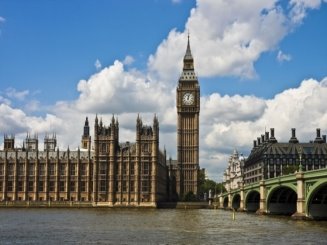Тема: «Виртуальное путешествие по Лондону». (”Virtual travelling around London”)
Цели:
– активизация тематической лексики УМК 8 класса в устной речи учащихся в диалогической и монологической форме в процессе развития иноязычной коммуникативной компетенции школьников
– углубление знаний учащихся о стране изучаемого иностранного языка (создание условий для «диалога культур»)
– воспитание потребности расширять свой кругозор, в том числе и за счет информации о странах изучаемого языка.
Формы проведения: интерактивная беседа, заочное путешествие.
Планируемые результаты
Личностные:
- Формирование мотивации к продолжению изучения английского языка; развитие стремления к самосовершенствованию в данной предметной области.
- Развитие навыков коллективной учебной деятельности, умение работать в паре(группе); установление дружеских взаимоотношений в коллективе, основанных на взаимопомощи и взаимной поддержке.
- Формирование устойчивой учебно-познавательной мотивации учения.
- Формирование коммуникативной компетентности в общении и сотрудничестве со сверстниками в процессе учебной деятельности.
- Формирование умения выражать эмоции и чувства адекватно.
- Развитие стремления к совершенствованию речевой культуры в целом.
- Воспитание ответственного отношения к изучению, развитие готовности и способности к саморазвитию.
- Формирование навыков самоанализа и самоконтроля.
Метапредметные
Коммуникативные
- Адекватно использовать речевые средства для решения различных коммуникативных задач.
- Вести диалог этикетного характера в ситуации бытового общения.
- Читать текст с целью поиска конкретной информации.
- Развивать коммуникативную компетенцию.
Регулятивные
- Развивать мотивы и интересы познавательной деятельности.
- Самостоятельно ставить цели, планировать пути их достижения.
- Осуществлять регулятивные действия самонаблюдения, самоконтроля и самооценки в процессе коммуникативной деятельности на английском языке.
Познавательные
- Создавать, применять и преобразовывать модели и схемы для решения учебных и познавательных задач.
- Выделять и фиксировать в тексте нужную информацию.
- Овладевать исследовательскими учебными действиями, в том числе навыками работы с информацией.
Ход урока
T: At our previous lessons we said that travelling is very often an important part of people’s life. There are many ways of travelling that attract a lot of tourists. Today I want you to elaborate upon this idea and prove this statement. You may use the key words cards which I am sure will give you idea and a good opportunity to practice your language skills. Will you look through the key words of Card 1.
|
Travelling | |
|
– to be impossible without travelling (people’s life) – to go on a business trip or to travel for pleasure(thousands of people) – different ways of travelling (there are) – to travel (by air, rail, sea, road, on foot) – to be the fastest and the most convenient way of travelling(by air) – the most expensive way of travelling(by plane) – to make the longest journey enjoyable – the main advantages of trains(speed, comfort and safety in comfortable seats of sleeping cars) – to prefer trains to other means of transport |
– to be very popular (travelling by sea – to go on a two-week cruise (travelling by ship) – to be very popular too(travelling by car) – to stop at any place you like – to spend at any place as much time as you like – to be very popular with young people – (hiking) – to enjoy the country side – to live in tents on the sea shore or in the forest – to breathe in fresh air and the sun all day – to play sports games and enjoy the sunset – to return home sun burnt and full of impressions |
T: Well, have you scanned the words and expressions which are familiar to you? I suppose you have, haven’t you? It’s time for us to start the conversation.
T: Is people’s life really impossible without travelling?
P1: I think people’s life is sometimes really impossible without travelling.
T: Why do people travel?
P2: There are different reasons for that, I believe. Some of them travel for pleasure and there are people who go on a business trip.
T: What ways of travelling do you know?
P3: Actually there are a lot of ways of travelling which anyone may choose. People may travel by air, by railway, by sea, by road and certainly on foot.
T: Which way of travelling is the fastest one?
P4: The fastest way of travelling is of course that by plane.
T: What about the advantages of travelling by train?
P5: I think speed, comfort and safely in comfortable seats of the sleeping cars are the main advantages of modern trains. All this makes the longest journey enjoyable.
T: Is travelling by sea popular too?
P6: Yes, travelling by ship is also popular with many tourists, who are happy to go a two-or three — week cruise to enjoy a lot of different places of interest in their country.
T: Why is travelling by very popular?
P7: This way of transport I think is also very popular because it’s very convenient. You needn’t to reserve tickets and you have an opportunity to stop wherever you wish. You may also spend at any place as much time as you like and have a good time.
T: What is good about hiking?
P8: It’s rather pleasant to feel nature every day. That’s why hiking is very popular with many young people who enjoy the countryside. It is really romantic to live in tents on the sea shore or in the forest. Besides it’s so nice to breathe in fresh air and enjoy the sun all day long.
T: What about sports activities people can be involved in when they are on a hiking trip?
P9: Playing sports is of course one of the most useful activities many young people are involved in when they are on hiking trip. But enjoying the sunset and returning home sunburn and full of impressions are enjoyable for everybody.
T: Thank you, boys and girls. I am pleased with your answers about travelling. At our English lesson I’d like to offer you to make a tour, to be more exact a virtual tour abroad. Are you interested to know what country it will be?
P: What country will it be?
T: Certainly Britain and its capital. And before going to the capital of the UK I want to see how well you know the names of the most famous London sights. Let us quickly read them for us to remember them better.
– Great Britain
– The United Kingdom
– England
– London
– The Thames River
– The Tower of London
– The tower Bridge
– The Houses of Parliament
– The British Parliament
– The house of Lords
– The House of Commons
– The Clock Tower
– Sir Benjamin Hall
– Big Ben
– St. Paul’s Cathedral
– Buckingham Palace
– Trafalgar Square
– Nelson’s Column
– The National Gallery
– Westminster Abbey
– The British Museum
– The London Eye
T: Now we may start our virtual excursion along the streets of London. Are you ready?
CL: Yes, we are
T: Good. And now we are to decide what way of travelling around London to choose. At the beginning of the lesson you said people may travel by air, by railway, by sea and so on. We may take a trip on a boat along the Thames or go for a drive in a London double-decker or take a coach tour. But there is also an unusual way to see London. I mean the London Observation Wheel which can help us to see the British capital above. So if you do not object to that try to imagine yourselves in its transparent pods. The key words of Card will give you the necessary information about this modern sight of the British capital.
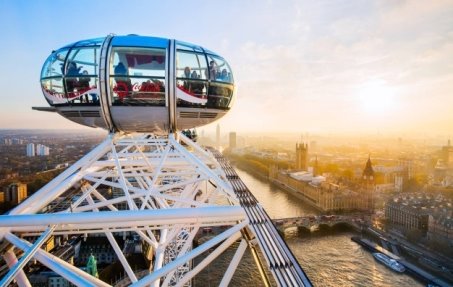
The Millennium Wheel or the London Eye
Say a few words about the Millennium Wheel using the words given in the card

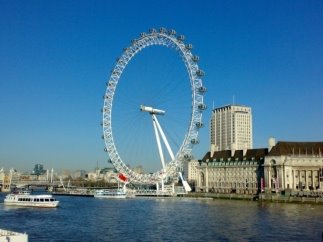
– to be known as the London Eye (to be 135 metres high)
– one of the most remarkable sights of London
– an observatory in the form of a gigantic wheel
– to be the world’s tallest observation wheel
– one of London’s outstanding attractions
– to have 32 transparent pods (the Millennium Wheel)
– to carry 800 passengers at any one time(can)
– one can witness views for 45 kilometers around
– to be open in the year 2000
– to work at a speed of about 0,5 kilometers per hour
– it takes 30 minutes to go right round once
– to attract a great number of visitors
T: Well, boys and girls, I want you to know more about London Observation Wheel. So Look at the key words of Card and tell us about the London Eye.
P1: The London EYE is also called the Millennium Wheel
P2: It is called so because it was opened in the year 2000 when one millennium ended and the other one started.
P3: In its 32 transparent pods it can carry 800 people at any one time and one can see views for 45 kilometers around.
P4: The Wheel works at a speed of about 0,5 kilometers per hour and it takes 30 minutes to go right round once.
T: You right. Thank you. But don’t forget you are in one of the pods of London Wheel now. So try to look around and say what other places of interest you can see from above. Card can help you
(говоря так, учитель на самом деле предлагает учащимся внимательно изучить снимок центральной части Лондона сверху и найти на нем известные детям достопримечательности столицы Британии)
London — capital of the UK- from above
Say a few words about London (“from above”) using the words given in the cards
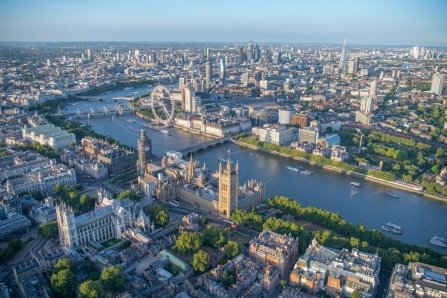
– to see the British capital from above
– to recognize at first sight (what?)
– the historical sights of London
– the Thames
– the Palace of Westminster (the Houses of Parliament)
– the Clock Tower of Big Ben
– Westminster Abbey
– the British TV Tower (165 metres high, opened in 1965)
– Trafalgar Square with Nelson’s Column and the National Gallery
– Buckingham Palace
P1: I can see some of famous historical sights of London.
T: What are they?
P2: First of all it’s the Tames River. Then I see the Palace of Westminster and the Clock Tower of Big Ben on the left.
P3: Westminster Abbey is behind. The British TV Tower which is 165 metres high is in the background. It was opened in 1965.
P4: There is also Trafalgar Square with Nelson’s Column and the Nation Gallery somewhere between the Houses of Parliament and the TV Tower. Buckingham Palace is somewhere on the left.
T: You are right. But now I want to ask some of you to try to be a guide and tell us information about some places of interest in London using the cards. Our key words cards will help you to speak in detail.
|
The Clock Tower | |
|
Say a few words about the Clock Tower using the words given in the card | |
|
|
– to be of great interest – to stand near Westminster Palace – to be built in the 19 th century (1858) – to have four faces(the clock) – to have a very loud bell – to weigh more than 13 tons(the bell) – Sir Benjamin Hall – to be in charge of the building of the Clock Tower – Big Ben – in honour of Sir Benjamin Hall (the tall man) – to call the clock, its bell and the Clock Tower itself |
T: Who wants to try to be a guide?
P1: May I try. It’s the Clock Tower (Big Ben). It is of course of great interest and I think many tourists want to it. It stands near Westminster Palace and the clock of tower has four faces. Inside there is a very loud bell which weights more than 13 tons. The tower was built in 1858. Sir Benjamin was in charge of the building of the Clock Tower. He was a very tall man. And in honour of Sir Benjamin Hall, the tall man, people called the clock, its bell and the Clock Tower itself Big Ben.
T: What about Trafalgar Square and the National Gallery?
Trafalgar Square
Say a few words about Trafalgar Square using the words given in the card
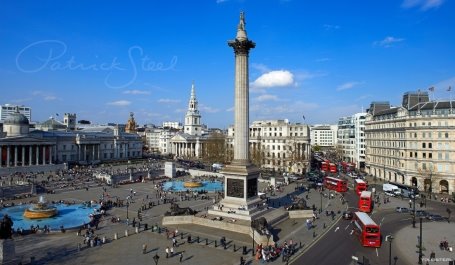
– one of the most famous attractions in London
– Nelson’s Column
– in the middle of the Square
– a statue of Nelson on the top of the Column
– the famous British admiral
– historical victories in the war against Napoleon
– to attract many tourists from other countries
P2: Trafalgar Square is one of the most famous attractions in London. In the middle of it there is Nelson’s Column with a statue of Nelson on the top. Nelson was the famous British Admiral whj won historical victories in the war against Napoleon. This historical place of interest of London attracts a lot of tourists from many countries of the world.
P3: As for the National Gallery it is situated in Trafalgar Square and contains a great variety of real masterpieces of art and sculpture. They were brought from many other countries of the whole world. A lot of visitors come of the world famous collection.
T: All right. Thank you. But there are also some other sights to admire. What are they?
The Tower of London
Say a few words about Trafalgar Square using the words given in the card
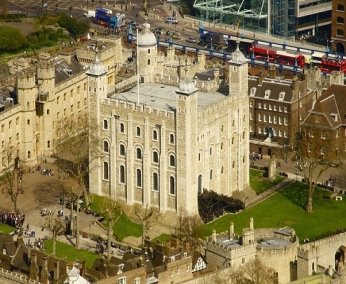
– to be very old
– in the early days of the history of England
– to live in the Tower (English kings)
– to be a royal palace, a castle, a fortress, a prison(in the past)
– to be a museum (now)
– half-a-dozen black ravens or so (to live at the Tower)
– to look after the ravens (the Yeoman Raven Master, to feed(the ravens)
– to exist as long as (Britain; a legend)
– to be famous for the nightly ritual of ceremony of the Key
– to lock the big doors for the night (the guard; at 10 p.m.)
P4: The tower of London is a very old sight of the British capital, In the early days of the history of England English kings lived in the Tower which was a royal palace, a castle, a fortress and a prison. Nowadays it is first of all a museum of the past where nevertheless half-a-dozen black ravens or so live. There is the Yeoman Raven Master to look after the ravens and to feed them. According to legend Britain will exist as long as there are ravens in the Tower.
T: What else is the Tower of London famous for?
P4: It is also famous for the nightly ritual of ceremony of the Key. This ceremony takes place at 10 p.m. when the quards lock the big doors of the Tower for the night.
T: All historical sights of London make the view of the British capital attractive. And there are some of them which are worth seeing and speaking about. Have a look at cards and name the sights
ST. Paul’s Cathedral
Say a few words about ST. Paul’s Cathedral using the words given in the card

– one of the most beautiful Renaissance building in the world
– to attract visitors from all over the world
– to contain many fine paintings, sculptures, monuments and works of art
– the greatest work of
– Christopher Wren
– the England’s architect
– to be finished in 1970 (the building of Cathedral)
– to be almost eighty already (Christopher Wren)
Buckingham Palace
Say a few words about Buckingham Palace using the words given in the card
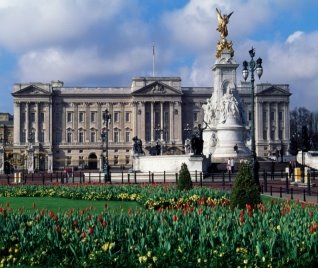
– one of the most remarkable sights of the British capital
– the official London Residence of the British Royal family
– Changing of Guard
– in front of the palace
– to attract a great number of Londoners and tourists from countries
P5: They are ST. Paul’s Cathedral, Buckingham Palace, Westminster Abbey and British Museum
T: You are right. And I want you to ask questions about the most important pages of their history.
P6: What is ST. Paul’s Cathedral famous for? What is the name of the architect who built it?
P7: ST. Paul’s Cathedral contains many fine paintings, sculptures, monuments and works of art. This fine building is the greatest work of Christopher Wren, the England’s architect of the 18 th century. And why is Buckingham Palace so important foe all Englishmen?
P8: Buckingham Palace is the official London Residence of the British Royal family. But what attracts a lot of people to this palace?
P9: It’s the Changing of Guard in front the palace.
T: If you learn the English language well enough you will be able to travel to Britain and see the London’s sight with your own eyes as well. And what about Westminster Abbey and the British Museum? You haven’t said a word about these sights of London, haven’t you?
Westminster Abbey
Say a few words about Westminster Abbey using the words given in the card
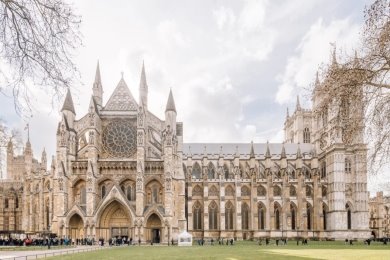
– to be situated in the centre of the British capital
– a world famous place of interest in London
– to attract a lot of visitors
– to be founded in 1065 by Edward the Confessor
– to be crowed in the past (all the English monarchs)
– to be buried in the Abbey
– many outstanding people of Britain
– Isaac Newton, Charles Darwin, Robert Burns, Dickens and Thackeray
– (among them)
– the Tomb of the Unknown Warrior
– to come and see(tourists)
P9: Who founded Westminster Abbey and when?
P10: It was founded in 1065 by Edward Confessor. All the English monarchs were crowned there in the past. But what else is it famous for?
P9: Westminster Abbey is also famous for many outstanding people who were buried there: Isaac Newton, Charles Darwin, Robert Burns, Dickens and Thackeray are among them. There is also the Tomb of the Unknown Warrior there.
T: All of these places of interest of London are brilliant exhibits of the history of the country whose language you are studying. And if you want to know the history of Britain well you may of course go to the British Museum. By the way, we are on an excursion now and you may scan Card and present some information about the British Museum as a London guide. Who wants to work as a guide?
The British Museum
Say a few words about the British Museum using the words given in the card
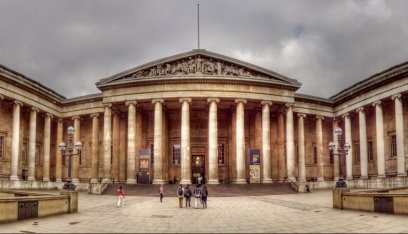
– to be a very interesting place to see
– to be the largest and most important cultural center in the world
– to be founded in 1753
– to be opened in 1759
– to house now more than seven million objects illustrating human history
– to be famous for its rich library till 1998 which contained millions of books written by great men of all countries of the whole world
– to be separated from the British Library which became independent with its own building in 1998
P1: Let me do it.
T: OK!
P1: We are in London now and I want all of you to look to the right. There is a very interesting place to see. It is the British Museum. The British Museum is the largest and most important cultural center in the world.
P2: I am sorry, when was it founded?
P1: It was founded in 1753.But it was opened to the public in 1759.
P3: Are you going to tell us anything about the exhibits of the museum?
P1: Don’t hurry. The collections of museum are very rich. I should say that the British Museum houses now more than seven objects illustrating human history.
P4: The British Museum has always been famous for its Library. What do you know about it?
P1: You are right. The collection of books of the British Library is really great and there are millions of books written by great men of all countries of the whole world. But the British Library occupied apart of the museum till 1998. After that the British Museum was separated from the British Library which became independent with its own building in 1998.
T: Very good. Our virtual excursion lesson is coming to an end. But I can’t give up speaking about one of the most remarkable modern sights of London. Our excursion we started with the London Eye, one of the latest modern sights of London. Do you remember that? And at the end of the lesson I’d like to draw your attention to such a sight a sight again and say what it is.
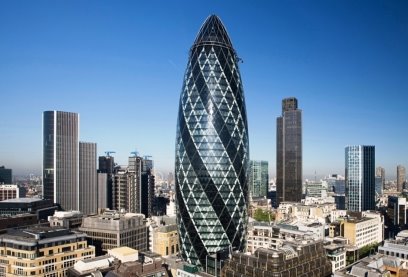
T: This building is a new skyscraper of the British capital. It looks like a bluish cigar-shaped construction. And it reminds us a cucumber. It is called the Gherkin. If you look up this word in the dictionary you are sure to see the translation «колючий огурец». And this is as you see an informal name of the new skyscraper of London. This 41-storey round building is 180 metres high. It was competed in 2004. The Gherkin is in the City of London. Do you like this building?
Cl: Yes, OK!
T: Thank you, boys and girls. I am pleased with your speaking at our today’s excursion lesson. You were good both at speaking about the things you know well. I’m glad that our key words cards helped you to organize both a useful discussion and the work of a guide. There is little time left before the end of the lesson but I’m sure you will be able to point out the right answers to the questions about the British capital sights
- What is the capital of the United Kingdom of Great Britain and Northern Ireland? (London)
- What is the name of the river on which the British capital is situated?
(The Thames)
- What was the Tower of London in the past first? (a fortress)
- When was the Clock Tower (Big Ben) near the Houses of Parliament built?
(1858)
- Who was in charge of the building of the London Clock Tower?
(Sir Benjamin)
- When was St.Paul’s Cathedral erected? (1710)
- What is the official London residence of the British Royal family?
(Buckingham Palace)
- What is Westminster Abbey? (a church)
- What has the British Museum always been famous for? (its library)
- Where were buried many outstanding people? (Westminster Abbey)
- When was the London Eye opened? (in the year 2000)
- What monument is there in the centre of Trafalgar Square? (Nelson Column with a statue of Nelson on the top)
T: Thank you very much! Your answers are wonderful! You have worked very well. I am satisfied with your work. Your marks are …
T: Объяснение домашнего задания: SB. Ex. 1, 2, p. 102
The lesson is over. You may be free. Good buy. We will see tomorrow/ Thank your for the lesson.
Литература:
- Учебник : Английский язык. 8 класс: учебник для общеобразовательных учреждений Ю. Е. Ваулина, Дж. Дули, О. Е. Подоляко, В. Эванс. — М.: Express Publishing: Просвещение, 2020. — (Английский в фокусе)
- Ю. И. Верисокин «Английский язык 8–11 классы. Развитие коммуникативных компетенций. Использование речевых опор.
- Ю. Б. Голицынский «Великобритания»
- В. В. Ощепкова «О Великобритании вкратце»
- Г. Д. Томахин «Страны Соединенного Королевства»
- А. В. Шереметьева «Английский язык. Страноведческий справочник
- Т. Ю. Журина «55 устных тем по английскому языку для школьников»
- Б. А. Смирнов «55 устных тем по английскому языку для подготовки к урокам»
